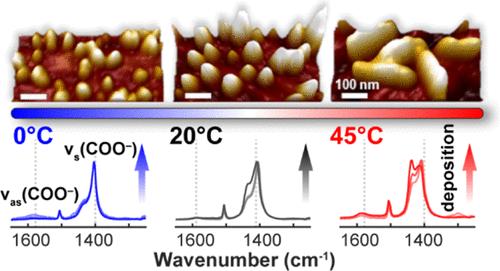沉积温度对Cu-BDC表面锚定金属-有机骨架形成的影响
IF 3.2
3区 化学
Q2 CHEMISTRY, PHYSICAL
引用次数: 0
摘要
表面锚定金属有机框架(surmof)是一种晶体、纳米孔、超分子材料,安装在衬底上,具有集成在各种电子、光子、传感和气体存储应用相关的器件架构中的潜力。本研究研究了在羧酸端自组装单层膜上,通过液相无机前驱体和有机前驱体交替沉积Cu-BDC(铜苯-1,4-二羧酸酯)MOF体系的薄膜形成。x射线衍射(XRD)和原子力显微镜(AFM)表征表明,Cu-BDC薄膜是通过Volmer-Weber生长形成的。AFM观察到随着沉积温度的升高,薄膜形态发生了变化,在较低温度下观察到更多孤立的纳米棒状晶体,而在较高温度下形成垂直的纳米片状结构。在45°C时,观察到纳米血小板由沿一个方向排列的熔融纳米棒片段组成。椭偏仪证实,温度升高和沉积循环次数增加都会产生更多的薄膜沉积,这与红外反射-吸收光谱(IRRAS)一致,红外反射-吸收光谱进一步用于表征表面结合Cu-BDC纳米结构的化学结合和取向。除了通过增强对称羧酸拉伸和缺乏反对称拉伸观察到纳米结构的强偏好取向外,IRRAS结果还表明,在更高的沉积温度和12次沉积循环后的高表面覆盖率下,出现了与片段纳米血小板形成相关的新结合基序。从BDC变形模式中出现的高频对称羧酸盐峰和峰分裂来看,IRRAS数据支持AFM观察到的Cu-BDC分段纳米血小板出现的应变结构的存在。本文章由计算机程序翻译,如有差异,请以英文原文为准。

Influence of Deposition Temperature on Cu-BDC Surface-Anchored Metal–Organic Framework Formation
Surface-anchored metal–organic frameworks (surMOFs) are crystalline, nanoporous, supramolecular materials mounted to substrates that have the potential for integration within device architectures relevant for a variety of electronic, photonic, sensing, and gas storage applications. This research investigates the thin film formation of the Cu-BDC (copper benzene-1,4-dicarboxylate) MOF system on a carboxylic acid-terminated self-assembled monolayer by alternating deposition of solution-phase inorganic and organic precursors. X-ray diffraction (XRD) and atomic force microscopy (AFM) characterization demonstrate that crystalline Cu-BDC thin films are formed via Volmer–Weber growth. Changes in film morphology as the deposition temperature increases are seen by AFM with more isolated nanorod-like crystallites observed at lower temperatures, while vertical nanoplatelet-like structures form at higher temperatures. At 45 °C, the nanoplatelets are observed to be composed of fused nanorod segments aligned in one direction. Ellipsometry confirms that both increasing temperature and number of deposition cycles yield more film deposition in agreement with infrared reflectance–absorbance spectroscopy (IRRAS) that was further used to characterize the chemical binding and orientation in the surface-bound Cu-BDC nanostructures. In addition to observing strong preferred orientation of the nanostructures from the enhancement of the symmetric carboxylate stretch and absence of the antisymmetric stretch, IRRAS results show the emergence of a new binding motif associated with segmented nanoplatelet formation at a higher deposition temperature as well as at high surface coverage after 12 deposition cycles. From the appearance of this higher frequency symmetric carboxylate peak alongside peak splitting in BDC deformation modes, IRRAS data support the presence of a strained configuration that accompanies the appearance of Cu-BDC segmented nanoplatelets observed by AFM.
求助全文
通过发布文献求助,成功后即可免费获取论文全文。
去求助
来源期刊

The Journal of Physical Chemistry C
化学-材料科学:综合
CiteScore
6.50
自引率
8.10%
发文量
2047
审稿时长
1.8 months
期刊介绍:
The Journal of Physical Chemistry A/B/C is devoted to reporting new and original experimental and theoretical basic research of interest to physical chemists, biophysical chemists, and chemical physicists.
 求助内容:
求助内容: 应助结果提醒方式:
应助结果提醒方式:


